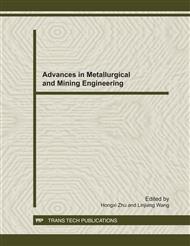p.362
p.365
p.371
p.374
p.380
p.386
p.390
p.397
p.403
Research on New Thermal Reduction Process of Magnesium Preparation at Ordinary Pressure with Serpentine as Raw Material
Abstract:
The traditional silicothermic process of magnesium metallurgy with dolomite at high temperature and under high vacuum condition results in high operation costs, discontinuous production and huge production consumption. Based on this, a new thermal reduction process of magnesium preparation is proposed with serpentine as raw material at ordinary pressure. It is shown by thermodynamic analysis that the calcined products of serpentine is the compound of 2MgO•SiO2 and MgO•SiO2. Furthermore, the thermal reduction process at ordinary pressure is determined by using calcined products of serpentine as raw material, CaC2 as reductant and CaO as additive. Comparing with traditional silicothermic process, the new process has many advantages due to higher magnesium content of serpentine, lower price of the reductant CaC2, lower reaction temperature in calcined and thermal reduction process, and ordinary pressure reaction conditions for continuous production.
Info:
Periodical:
Pages:
380-385
Citation:
Online since:
November 2011
Authors:
Price:
Сopyright:
© 2012 Trans Tech Publications Ltd. All Rights Reserved
Share:
Citation:


